Islamic world contributions to Medieval Europe: Difference between revisions
Al Kindi is not known to have produced a law of gravity |
m →Arts: Main |
||
| Line 97: | Line 97: | ||
===Arts=== |
===Arts=== |
||
{{ |
{{Main|Islamic influences on Christian art}} |
||
{{See also|Islamic art}} |
|||
Numerous techniques from [[Islamic art]] formed the basis of Arab-Norman art: inlays in [[mosaic]]s or [[metal]]s, sculpture of [[ivory]] or [[Porphyry (geology)|porphyry]], sculpture of hard stones, bronze [[Foundry|foundries]], manufacture of [[silk]] (for which [[Roger II of Sicily]] established a ''regium ergasterium'', a state enterprise which would give [[Sicily]] the monopoly of silk manufacture for all Europe).<ref>Pierre Aubé (2006), ''Les empires normands d’Orient'', p. 164-5, Editions Perrin, ISBN 2262022976</ref> |
Numerous techniques from [[Islamic art]] formed the basis of Arab-Norman art: inlays in [[mosaic]]s or [[metal]]s, sculpture of [[ivory]] or [[Porphyry (geology)|porphyry]], sculpture of hard stones, bronze [[Foundry|foundries]], manufacture of [[silk]] (for which [[Roger II of Sicily]] established a ''regium ergasterium'', a state enterprise which would give [[Sicily]] the monopoly of silk manufacture for all Europe).<ref>Pierre Aubé (2006), ''Les empires normands d’Orient'', p. 164-5, Editions Perrin, ISBN 2262022976</ref> |
||
Revision as of 20:53, 1 March 2010
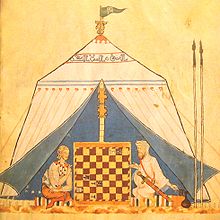
Islamic contributions to Medieval Europe were numerous, affecting such varied areas as art, architecture, medicine, agriculture, music, language, education, law, and technology. From the 11th to the 13th century, Europe absorbed knowledge from the Islamic civilization. Of particular importance was the rediscovery of the ancient classic texts, most notably the work of the Greek natural philosopher Aristotle, through retranslations from Arabic. In the early 20th century the musicologist Henry George Farmer wrote that a "growing number of scholars...recognize(d) that the influence of the Muslim civilization as a whole on medieval Europe was enormous in such fields as science, philosophy, theology, literature, aesthetics, than has been recognized."[2] For many historians the contributions from the Islamic world have had a considerable effect on the development of Western civilization and contributed to the achievements of the Renaissance.[3]
Use of the term "Islam"
The word "Islam" can refer either to the religion or to the whole civilization that was associated with Islam in Medieval times (see Islamic Golden Age). In this article, "Islam" is used in the meaning of a civilization and not that of a religion.
Transmission routes

The points of contact between Europe and Islamic lands were multiple during the Middle Ages. The main points of transmission of Islamic knowledge to Europe were in Sicily, and in Islamic Spain, particularly in Toledo (with Gerard of Cremone, 1114–1187, following the conquest of the city by the Spanish Christians in 1085). In Sicily, following the Islamic conquest of the island in 965 and its reconquest by the Normans in 1091, an intense Arab-Norman culture developed, exemplified by rulers such as Roger II, who had Islamic soldiers, poets and scientists at his court. One of the greatest geographical treatises of the Middle Ages was written by the Moroccan Muhammad al-Idrisi for Roger, and entitled Kitab Rudjdjar ("Tabula Rogeriana" or "The book of Roger").[4]
The Crusades also intensified exchanges between Europe and the Levant, with Italian City Republics taking a great role in these exchanges. In the Levant, such cities as Antioch, Arab and Latin cultures intermixed intensively.[5]
Classical knowledge
Following the fall of the Roman Empire and the dawn of the Middle Ages, many texts from Classical Antiquity had been lost to the Europeans. In the Middle East however, many of these Greek texts (such as Aristotle) were translated from Greek into Syriac during the 6th and the 7th century by Nestorian, Melkites or Jacobite monks living in Palestine, or by Greek exiles from Athens or Edessa who visited Islamic Universities. Many of these texts however were then kept, translated, and developed upon by the Islamic world, especially in centers of learning such as Baghdad, where a “House of Wisdom”, with thousands of manuscripts existed as soon as 832. These texts were translated again into European languages during the Middle Ages.[1] Eastern Christians played an important role in exploiting this knowledge, especially through the Christian Aristotelician School of Baghdad in the 11th and 12th centuries.
These texts were translated back into Latin in multiple ways. The main points of transmission of Islamic knowledge to Europe were in Sicilia, and in Toledo, Spain (with Gerard of Cremone, 1114–1187). Burgondio of Pise (died in 1193), who discovered in Antioch lost texts of Aristotle, translated them into Latin.
Islamic sciences
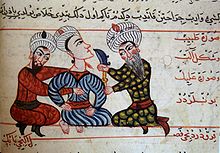
Islam was not, however, a simple re-transmitter of knowledge from antiquity. It also developed its own sciences, such as algebra, chemistry, geology, spherical trigonometry, etc. which were later also transmitted to the West.[6][7] Stefan of Pise translated into Latin around 1127 an Arab manual of medical theory. The method of algorism for performing arithmetic with Indian-Arabic numerals was developed by al-Khwarizmi (hence the word “Algorithm”) in the 9th century, and introduced in Europe by Leonardo Fibonacci (1170–1250).[8] A translation of the Algebra by al-Kharizmi is known as early as 1145, by a certain Robert of Chester. Ibn al-Haytham (Alhazen, 980-1037) compiled treaties on optical sciences, which were used as references by Newton and Descartes. Medical sciences were also highly developed in Islam as testified by the Crusaders, who relied on Arab doctors on numerous occasions. Joinville reports he was saved in 1250 by a “Saracen” doctor.[9]
Contributing to the growth of European science was the major search by European scholars for new learning which they could only find among Muslims, especially in Islamic Spain and Sicily. These scholars translated new scientific and philosophical texts from Arabic into Latin.
One of the most productive translators in Spain was Gerard of Cremona, who translated 87 books from Arabic to Latin,[10] including Muhammad ibn Mūsā al-Khwārizmī's On Algebra and Almucabala, Jabir ibn Aflah's Elementa astronomica,[11] al-Kindi's On Optics, Ahmad ibn Muhammad ibn Kathīr al-Farghānī's On Elements of Astronomy on the Celestial Motions, al-Farabi's On the Classification of the Sciences,[12] the chemical and medical works of Rhazes,[13] the works of Thabit ibn Qurra and Hunayn ibn Ishaq,[14] and the works of Arzachel, Jabir ibn Aflah, the Banū Mūsā, Abū Kāmil Shujā ibn Aslam, Abu al-Qasim, and Ibn al-Haytham (including the Book of Optics).[10]
Alchemy and chemistry
The chemical and alchemical works of Geber (Jabir ibn Hayyan) were translated into Latin around the 12th century and became standard texts for European alchemists.[13] These include the Kitab al-Kimya (titled Book of the Composition of Alchemy in Europe), translated by Robert of Chester (1144); and the Kitab al-Sab'een, translated by Gerard of Cremona (before 1187).
Marcelin Berthelot translated some of Jabir's books under the fanciful titles Book of the Kingdom, Book of the Balances, and Book of Eastern Mercury. Several technical Arabic terms introduced by Jabir, such as alkali, have found their way into various European languages and have become part of scientific vocabulary.
The chemical and alchemical works of Muhammad ibn Zakarīya Rāzi (Rhazes) were also translated into Latin around the 12th century.[13]
Astronomy and mathematics

Arabic astronomical and mathematical works translated into Latin during the 12th century include the works of Muhammad ibn Jābir al-Harrānī al-Battānī and Muhammad ibn Mūsā al-Khwārizmī, including The Compendious Book on Calculation by Completion and Balancing, one of the founding texts of algebra;[11] and Muhammad al-Fazari's Great Sindhind (based on the Surya Siddhanta and the works of Brahmagupta).[15]

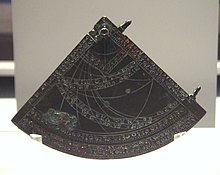
Al-Khazini's Zij as-Sanjari (1115–1116) was translated into Greek by Gregory Choniades in the 13th century and was studied in the Byzantine Empire.[16] The astronomical modifications to the Ptolemaic model made by al-Battani and Averroes led to non-Ptolemaic models produced by Mo'ayyeduddin Urdi (Urdi lemma), Nasīr al-Dīn al-Tūsī (Tusi-couple) and Ibn al-Shatir, which were later adapted into the Copernican heliocentric model. Abū al-Rayhān al-Bīrūnī's Ta'rikh al-Hind and Kitab al-qanun al-Mas’udi were translated into Latin as Indica and Canon Mas’udicus respectively.
Fibonacci presented the first complete European account of the Hindu-Arabic numeral system from Arabic sources in his Liber Abaci (1202).[13] Al-Jayyani's The book of unknown arcs of a sphere, the first treatise on spherical trigonometry, had a "strong influence on European mathematics", and his "definition of ratios as numbers" and "method of solving a spherical triangle when all sides are unknown" are likely to have influenced Regiomontanus.[17]
Translations of the algebraic and geometrical works of Ibn al-Haytham, Omar Khayyám and Nasīr al-Dīn al-Tūsī were later influential in the development of non-Euclidean geometry in Europe from the 17th century.[18][19]
Medicine
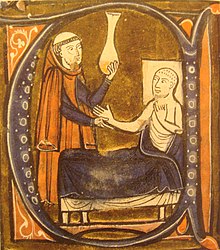

Hospitals began as Bimaristans in the Islamic world and later spread to Europe during the Crusades, inspired by the hospitals in the Middle East. The first hospital in Paris, Les Quinze-vingt, was founded by Louis IX after his return from the Crusade between 1254-1260.[21] One of the most important medical works to be translated was Avicenna's The Canon of Medicine (1025), which was translated into Latin and then disseminated in manuscript and printed form throughout Europe. It remained a standard medical textbook in Europe up until the early modern period, and during the fifteenth and sixteenth centuries alone, The Canon of Medicine was published more than thirty-five times.[22] It introduced the contagious nature of infectious diseases, the method of quarantine, experimental medicine, and clinical trials.[23] He also wrote The Book of Healing, a more general encyclopedia of science and philosophy, which became another popular textbook in Europe. Muhammad ibn Zakarīya Rāzi's Comprehensive Book of Medicine, with its introduction of measles and smallpox, was also influential in Europe. Abu al-Qasim al-Zahrawi's Kitab al-Tasrif was also translated to Latin and used in European medical schools for centuries.[10][24]
Ibn al-Nafis' Commentary on Compound Drugs was translated into Latin by Andrea Alpago (d. 1522), who may or may not have also translated (with out publication) Ibn al-Nafis' Commentary on Anatomy in the Canon of Avicenna, which first described pulmonary circulation and which might have had an influence on Michael Servetus and Realdo Colombo if they saw it.[25]
Physics
One of the most important scientific works to be translated was Ibn al-Haytham's Book of Optics (1021), which initiated a revolution in optics[26] and visual perception,[27] and introduced the earliest experimental scientific method,[28] for which Ibn al-Haytham is considered the "father of modern optics"[29] and founder of experimental physics.[30][31] The Book of Optics laid the foundations for modern optics,[29] the scientific method,[28] experimental physics[30] and experimental psychology,[32] for which it has been ranked alongside Isaac Newton's Philosophiae Naturalis Principia Mathematica as one of the most influential books in the history of physics.[33] The Latin translation of the Book of Optics influenced the works of many later European scientists, such as Robert Grosseteste, Roger Bacon, John Peckham, Witelo, William of Ockham, Leonardo da Vinci, Francis Bacon, René Descartes, Johannes Kepler, Galileo Galilei, Isaac Newton, and others.[34][35] The Book of Optics also laid the foundations for a variety of Western optical technologies, such as eyeglasses,[36] the camera,[37] the telescope and microscope, microscopy, retinal surgery, and robotic vision.[35] The book also influenced other aspects of European culture. In religion, for example, John Wycliffe, the intellectual progenitor of the Protestant Reformation, referred to Alhazen in discussing the seven deadly sins in terms of the distortions in the seven types of mirrors analyzed in De aspectibus. In literature, Alhazen's Book of Optics is praised in Guillaume de Lorris' Roman de la Rose.[38] In art in particular, the Book of Optics laid the foundations for the linear perspective technique and the use of optical aids in Renaissance art (see Hockney-Falco thesis).[38] The linear perspective technique was also employed in European geographical charts during the Age of Exploration, such as Paolo Toscanelli's chart which was used by Christopher Columbus when he went on a voyage to the New World.[35]
The theories of motion in Islamic physics developed by Avicenna and Avempace influenced Jean Buridan's theory of impetus, the ancestor of the inertia and momentum concepts, and the work of Galileo Galilei on classical mechanics.[39] The work of Abū Rayhān al-Bīrūnī and al-Khazini on mechanics, particularly statics and dynamics, were also adopted and further developed in medieval Europe.[40]
Other works
Other Arabic works translated into Latin during the 12th century include the works of Razi and Avicenna (including The Book of Healing and The Canon of Medicine),[41] the works of Averroes,[24] the works of Thabit ibn Qurra, al-Farabi, Ahmad ibn Muhammad ibn Kathīr al-Farghānī, Hunayn ibn Ishaq, and his nephew Hubaysh ibn al-Hasan,[42] the works of al-Kindi, Abraham bar Hiyya's Liber embadorum, Ibn Sarabi's (Serapion Junior) De Simplicibus,[24] the works of Qusta ibn Luqa,[43] the works of Maslamah Ibn Ahmad al-Majriti, Ja'far ibn Muhammad Abu Ma'shar al-Balkhi, and al-Ghazali,[10] the works of Nur Ed-Din Al Betrugi, including On the Motions of the Heavens,[13][44] Ali ibn Abbas al-Majusi's medical encyclopedia, The Complete Book of the Medical Art,[13] Abu Mashar's Introduction to Astrology,[45] the works of Maimonides, Ibn Zezla (Byngezla), Masawaiyh, Serapion, al-Qifti, and Albe'thar.[46] Abū Kāmil Shujā ibn Aslam's Algebra,[11] and the De Proprietatibus Elementorum, an Arabic work on geology written by a pseudo-Aristotle.[13] By the beginning of the 13th century, Mark of Toledo translated the Qur'an and various medical works.[47]
Ibn Tufail's Hayy ibn Yaqdhan was translated into Latin by Edward Pococke in 1671 and into English by Simon Ockley in 1708 and became "one of the most important books that heralded the Scientific Revolution."[48] Ibn al-Baitar's Kitab al-Jami fi al-Adwiya al-Mufrada also had an influence on European botany after it was translated into Latin in 1758.[49]
Islamic techniques
In the 12th century, Europe owed Islam an agricultural revolution (see Muslim Agricultural Revolution), due to the progressive introduction into Europe of various unknown fruits: the artichoke, spinachs, aubergines, peaches, apricots.[50]
Numerous new techniques in clothing, as well as new materials were also introduced: muslin, taffetas, satin, skirts. Trade mechanisms were also transmitted: tariffs, customs, bazars, magazins.
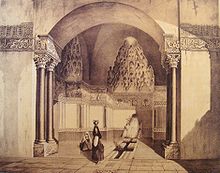
Arts
Numerous techniques from Islamic art formed the basis of Arab-Norman art: inlays in mosaics or metals, sculpture of ivory or porphyry, sculpture of hard stones, bronze foundries, manufacture of silk (for which Roger II of Sicily established a regium ergasterium, a state enterprise which would give Sicily the monopoly of silk manufacture for all Europe).[52]
Writing: Western imitations of Arabic script
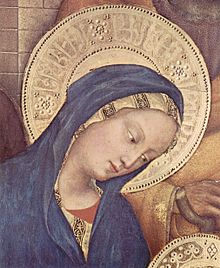
The Arabic Kufic script was often imitated in the West during the Middle-Ages and the Renaissance, to produce what is known as pseudo-Kufic: "Imitations of Arabic in European art are often described as pseudo-Kufic, borrowing the term for an Arabic script that emphasizes straight and angular strokes, and is most commonly used in Islamic architectural decoration".[54] Numerous cases of pseudo-Kufic are known from European art from around the 10th to the 15th century. Pseudo-Kufic would be used as writing or as decorative elements in textiles, religious halos or frames. Many are visible in the paintings of Giotto.[55] The exact reason for the incorporation of pseudo-Kufic in early Renaissance painting is unclear. It seems that Westerners mistakenly associated 13-14th century Middle-Eastern scripts as being identical with the scripts current during Jesus's time, and thus found natural to represent early Christians in association with them:[56] "In Renaissance art, pseudo-Kufic script was used to decorate the costumes of Old Testament heroes like David".[57] Another reason might be that artist wished to express a cultural universality for the Christian faith, by blending together various written languages, at a time when the church had strong international ambitions.[58]
Architecture
Gothic architecture may have been influenced by Islamic architecture. According to one theory, the introduction of the pointed arch in Europe which roughly coincided with the Norman conquest of Islamic Sicily in 1090, the Crusades which began in 1096, and the Islamic presence in Spain, brought about a knowledge of this significant structural device. It is probable also that decorative carved stone screens and window openings filled with pierced stone also influenced Gothic tracery. In Spain, in particular, individual decorative motifs occur which are common to both Islamic and Christian architectural mouldings and sculpture.[59][60]
Painting: Islamic carpets in European painting
Right image: Re-entrant prayer rug, Anatolia, late 15th to early 16th century.
Islamic carpets of Middle-Eastern origin, either from the Ottoman Empire, the Levant or the Mamluk state of Egypt or Northern Africa, were used as important decorative features in paintings from the 13th century onwards, starting from the Medieval period and continuing into the Renaissance period. Such carpets were often integrated into Christian imagery as symbols of luxury and status of Middle-Eastern origin, and together with Pseudo-Kufic script offer an interesting example of the integration of Eastern elements into European painting.
Institutions
Europe adopted a number of educational, legal and scientific institutions from the Islamic world, including the public hospital (which replaced healing temples and sleep temples)[61] and psychiatric hospital,[62] the public library and lending library, the academic degree-granting university (see Madrasah), the astronomical observatory as a research institute[61] (as opposed to a private observation post as was the case in ancient times)[63] (see Islamic astronomy), the trust institution and charitable trust (see Waqf),[64][65] the agency and aval (Hawala),[66] and a variety of other such institutions.
Music
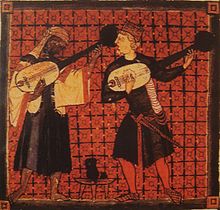
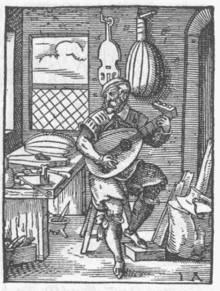
A number of musical instruments used in classical music are believed to have been derived from Arabic musical instruments: the lute was derived from the al'ud, the rebec (ancestor of violin) from the rebab, the guitar from qitara, naker from naqareh, adufe from al-duff, alboka from al-buq, anafil from al-nafir, exabeba from al-shabbaba (flute), atabal (bass drum) from al-tabl, atambal from al-tinbal,[67] the balaban, the castanet from kasatan, sonajas de azófar from sunuj al-sufr, the conical bore wind instruments,[68] the xelami from the sulami or fistula (flute or musical pipe),[69] the shawm and dulzaina from the reed instruments zamr and al-zurna,[70] the gaita from the ghaita, rackett from iraqya or iraqiyya,[71] the harp and zither from the qanun,[72] canon from qanun, geige (violin) from ghichak,[73] and the theorbo from the tarab.[74]
According to a common theory on the origins of the troubadour, a composer of medieval lyric poetry, it may have had Arabic origins. Ezra Pound, in his Canto VIII, famously declared that William of Aquitaine "had brought the song up out of Spain / with the singers and veils..." referring to the troubadour song. In his study, Lévi-Provençal is said to have found four Arabo-Hispanic verses nearly or completely recopied in William's manuscript. According to historic sources, William VIII, the father of William, brought to Poitiers hundreds of Muslim prisoners.[75] Trend admitted that the troubadours derived their sense of form and even the subject matter of their poetry from the Andalusian Muslims.[76] The hypothesis that the troubadour tradition was created, more or less, by William after his experience of Moorish arts while fighting with the Reconquista in Spain was also championed by Ramón Menéndez Pidal in the early twentieth-century, but its origins go back to the Cinquecento and Giammaria Barbieri (died 1575) and Juan Andrés (died 1822). Meg Bogin, English translator of the trobairitz, held this hypothesis. Certainly "a body of song of comparable intensity, profanity and eroticism [existed] in Arabic from the second half of the 9th century onwards."[77]
Another theory on the origins of the Western solfège musical notation suggests that it may have also had Arabic origins. It has been argued that the solfège syllables (do, re, mi, fa, sol, la, ti) may have been derived from the syllables of the Arabic solmization system Durr-i-Mufassal ("Separated Pearls") (dal, ra, mim, fa, sad, lam). This origin theory was first proposed by Meninski in his Thesaurus Linguarum Orientalum (1680) and then by Laborde in his Essai sur la Musique Ancienne et Moderne (1780).[78][79]
Technology
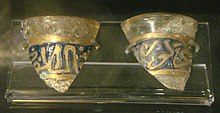
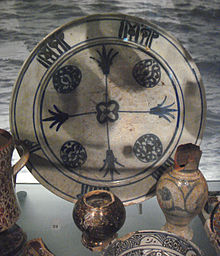
A number of technologies in the Islamic world were adopted in European medieval technology. These included various crops;[80] Greek inventions such as the astrolabe; and a variety of original Muslim inventions, including astronomical instruments such as the quadrant (including the Quadrans Vetus, a universal horary quadrant which could be used for any latitude,[81] and the Quadrans Novus, an astrolabic quadrant)[82] and sextant, a universal astrolabe invented by Abū Ishāq Ibrāhīm al-Zarqālī known as the Saphaea in Europe, the "observation tube" (without lens) which influenced the development of the telescope,[83] cobwork (tabya),[84] street lamps,[85] waste containers and waste disposal facilities for litter collection,[86] weight-driven mechanical clocks with escapement mechanisms,[87] segmental gears[88] ("a piece for receiving or communicating reciprocating motion from or to a cogwheel, consisting of a sector of a circular gear, or ring, having cogs on the periphery, or face"),[89] distilled alcohol (ethanol) described by Muslim chemists,[90] over 200 surgical instruments described in Abu al-Qasim al-Zahrawi's Al-Tasrif, explosive compositions of gunpowder, the baculus used for nautical astronomy, and various other technologies. The importation of both the ancient and new technology from the Middle East and the Orient to Renaissance Europe represented “one of the largest technology transfers in world history.”[91]
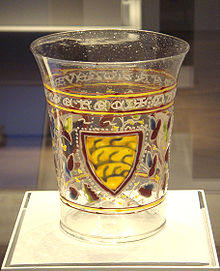
The Muslim Agricultural Revolution in particular diffused a large number of crops and technologies into medieval Europe, where farming was mostly restricted to wheat strains obtained much earlier via central Asia. Spain received what she in turn transmitted to the rest of Europe; many agricultural and fruit-growing processes, together with many new plants, fruit and vegetables. These new crops included sugar cane, rice, citrus fruit, apricots, cotton, artichokes, aubergines, and saffron. Others, previously known, were further developed. Muslims also brought to that country lemons, oranges, cotton, almonds, figs and sub-tropical crops such as bananas and sugar cane. Several were later exported from Spanish coastal areas to the Spanish colonies in the New World. Also transmitted via Muslim influence, a silk industry flourished, flax was cultivated and linen exported, and esparto grass, which grew wild in the more arid parts, was collected and turned into various articles.[80] Industries established for sugar plantations,[93] ceramics, distillation technologies, clocks, mechanical hydropowered and wind powered machinery, matting, pulp and paper, perfumery, silk, sugar, water, and the mining of minerals such as sulfur and ammonia, were transferred from the Islamic world to medieval Europe.[94] Factory installations and a variety of industrial mills (including fulling mills, gristmills, hullers, paper mills and sugar mills may have also been transmitted to medieval Europe,[95] along with the suction pump (which also incorporated a crankshaft-connecting rod mechanism) invented by al-Jazari,[96][97] noria and chain pumps for irrigation purposes.[98] These innovations made it possible for many industrial operations that were previously driven by manual labour to be driven by machinery in medieval Europe.[99]
Economics

Some writers trace back the earliest stages of merchant capitalism to the Caliphate during the 9th-12th centuries, where a vigorous monetary market economy was created on the basis of the expanding levels of circulation of a stable high-value currency (the dinar) and the integration of monetary areas that were previously independent. Innovative new business techniques and forms of business organization were introduced by economists, merchants and traders during this time. Such innovations included trading companies, bills of exchange, big businesses, the first forms of partnership (mufawada in Arabic) such as limited partnerships (mudaraba) (mufawada partnership possessed features similar to those of the medieval family compagnia in Europe[100]), and the concepts of credit, profit, capital (al-mal) and capital accumulation (nama al-mal). Many of these early capitalist ideas were further advanced in medieval Europe from the 13th century onwards.[101][102][103]
Education
The origins of the college lies in the medieval Islamic world. The madrasah was the earliest example of a college, mainly teaching Islamic law and theology, usually affiliated with a mosque, and funded by Waqf, which were the basis for the charitable trusts that later funded the first European colleges. The internal organization of the early European college was also borrowed from the earlier madrasah, like the system of fellows and scholars, with the Latin term for fellow, socius, being a direct translation of the Arabic term for fellow, sahib.[104] Madrasahs were also the first law schools, and it is likely that the "law schools known as Inns of Court in England" may have been derived from the madrasahs which taught Islamic law and jurisprudence.[105]
If a university is assumed to mean an institution of higher education and research which issues academic degrees at both undergraduate and postgraduate levels, then the Jami'ah which appeared from the 9th century were the first examples of such an institution.[104][106] The University of Al Karaouine in Fez, Morocco is thus recognized by the Guinness Book of World Records as the oldest degree-granting university in the world with its founding in 859 by Fatima al-Fihri.[107] However, the madrasah differed from the medieval university of Europe in several important respects, namely that the degree took the form of a license (ijazah) which "was signed in the name of the teacher, not of the madrasa".[108] In other words, "the authorization or licensing was done by each professor, not by a group or corporate body, much less by a disinterested or impersonal certifying body".[109] The first colleges and universities in Europe were nevertheless influenced in many ways by the madrasahs in Islamic Spain and the Emirate of Sicily at the time, and in the Middle East during the Crusades.[106]
The origins of the doctorate dates back to the ijazat attadris wa 'l-ifta' ("license to teach and issue legal opinions") in the medieval Islamic legal education system, which was equivalent to the Doctor of Laws qualification and was developed during the 9th century after the formation of the Madh'hab legal schools. To obtain a doctorate, a student "had to study in a guild school of law, usually four years for the basic undergraduate course" and ten or more years for a post-graduate course. The "doctorate was obtained after an oral examination to determine the originality of the candidate's theses," and to test the student's "ability to defend them against all objections, in disputations set up for the purpose" which were scholarly exercises practiced throughout the student's "career as a graduate student of law." After students completed their post-graduate education, they were awarded doctorates giving them the status of faqih (meaning "master of law"), mufti (meaning "professor of legal opinions") and mudarris (meaning "teacher"), which were later translated into Latin as magister, professor and doctor respectively.[106] The term doctorate comes from the Latin docere, meaning "to teach", shortened from the full Latin title licentia docendi meaning "license to teach." This was translated from the Arabic term ijazat attadris, which means the same thing and was awarded to Islamic scholars who were qualified to teach. Similarly, the Latin term doctor, meaning "teacher", was translated from the Arabic term mudarris, which also means the same thing and was awarded to qualified Islamic teachers.[106] The Latin term baccalaureus may have also been transliterated from the equivalent Arabic qualification bi haqq al-riwaya ("the right to teach on the authority of another").[104]
According to Professor George Makdisi and Hugh Goddard, some of the terms and concepts now used in modern universities which have Islamic origins include "the fact that we still talk of professors holding the 'Chair' of their subject" being based on the "traditional Islamic pattern of teaching where the professor sits on a chair and the students sit around him", the term 'academic circles' being derived from the way in which Islamic students "sat in a circle around their professor", and terms such as "having 'fellows', 'reading' a subject, and obtaining 'degrees', can all be traced back" to the Islamic concepts of Ashab ("companions, as of the prophet Muhammad"), Qara'a ("reading aloud the Qur'an") and Ijazah ("license to teach") respectively. Makdisi has listed eighteen such parallels in terminology which can be traced back to their roots in Islamic education. Some of the practices now common in modern universities which Makdisi and Goddard trace back to an Islamic root include "practices such as delivering inaugural lectures, wearing academic robes, obtaining doctorates by defending a thesis, and even the idea of academic freedom are also modelled on Islamic custom." The Islamic scholarly system of fatwa and ijma, meaning opinion and consensus respectively, formed the basis of the "scholarly system the West has practised in university scholarship from the Middle Ages down to the present day."[106] According to Makdisi and Goddard, "the idea of academic freedom" in universities was "modelled on Islamic custom" as practiced in the medieval Madrasah system from the 9th century. Islamic influence was "certainly discernible in the foundation of the first delibrately-planned university" in Europe, the University of Naples Federico II founded by Frederick II, Holy Roman Emperor in 1224.[110]
Law
Since the publication of legal scholar John Makdisi's "The Islamic Origins of the Common Law" in the North Carolina Law Review,[105] there has been controversy over whether English common law was inspired by medieval Islamic law.[111] Several scholars have argued that several fundamental common law institutions may have been adapted from similar legal institutions in Islamic law and jurisprudence, and introduced to England after the Norman conquest of England by the Normans, who conquered and inherited the Islamic legal administration of the Emirate of Sicily (see Arab-Norman culture).[105] In his 1999 paper, Makdisi drew comparisons between the "royal English contract protected by the action of debt" and the "Islamic Aqd", the "English assize of novel disseisin" and the "Islamic Istihqaq", and the "English jury" and the "Islamic Lafif" in classical Maliki jurisprudence, and argued that these institutions were transmitted to England by the Normans,[105] "through the close connection between the Norman kingdoms of Roger II in Sicily — ruling over a conquered Islamic administration — and Henry II in England."[112] Makdisi also argued that English legal institutions such as "the scholastic method, the license to teach," the "law schools known as Inns of Court" in England (which he asserts are parallel to Madrasas in Islam) and the "European commenda" (parallel to Islamic Qirad) may have also originated from Islamic law.[105] He states that the methodology of legal precedent and reasoning by analogy (Qiyas) are also similar in both the Islamic and common law systems.[113] Makdisi claims these similarities and influences suggest that Islamic law may have laid the foundations for "the common law as an integrated whole".[105]
Other legal scholars such as Monica Gaudiosi, Gamal Moursi Badr and A. Hudson have argued that the English trust and agency institutions in common law, which were introduced by Crusaders, may have been adapted from the Islamic Waqf and Hawala institutions they came across in the Middle East.[66][114][115] Dr. Paul Brand also notes parallels between the Waqf and the trusts used to establish Merton College by Walter de Merton, who had connections with the Knights Templar. Brand also points out, however, that the Knights Templar were primarily concerned with fighting the Muslims rather than learning from them, making it less likely that they had knowledge of Muslim legal institutions.[111]
Several legal institutions in civil law were also adapted from similar institutions in Islamic law and jurisprudence during the Middle Ages. For example, the Islamic Hawala institution influenced the development of the Avallo in Italian civil law and the Aval in French civil law.[116] The commenda limited partnership used in European civil law was also adapted from the Qirad and Mudaraba in Islamic law. The civil law conception of res judicata[105] and the transfer of debt, which was not permissible under Roman law but is practiced in modern civil law, may also have origins in Islamic law. The concept of an agency was also an "institution unknown to Roman law", where it was not possible for an individual to "conclude a binding contract on behalf of another as his agent."[117]
Islamic law also introduced "two fundamental principles to the West, on which were to later stand the future structure of law: equity and good faith",[118] which was a precursor to the concept of pacta sunt servanda in civil law and international law. Another influence of Islamic law on the civil law tradition was the presumption of innocence, which was introduced to Europe by Louis IX of France soon after he returned from Palestine during the Crusades. Islamic law was based on the presumption of innocence from its beginning, as declared by the caliph Umar in the 7th century.[118]
There is evidence that early Islamic international law influenced the development of European international law, through various routes such as the Crusades, Norman conquest of the Emirate of Sicily, and Reconquista of al-Andalus.[118] In particular, the Spanish jurist Francisco de Vitoria, and his successor Grotius, may have been influenced by Islamic international law through earlier Islamic-influenced writings such as the 1263 work Siete Partidas of Alfonso X, which was regarded as a "monument of legal science" in Europe at the time and was influenced by the Islamic legal treatise Villiyet written in Islamic Spain.[118][119]
A number of Islamic legal concepts on human rights may have also influenced European legal systems, including concepts such as the charitable trust, trusteeship of property, human dignity, dignity of labour,[120] condemnation of antisocial behavior, presumption of innocence, caring, women's rights, privacy, juristic personality, individual freedom, equality before the law, non-retroactivity, limited sovereignty, tolerance.[120] Many of these concepts were adopted in medieval Europe through contacts with Islamic Spain and the Emirate of Sicily, and through the Crusades and the Latin translations of the 12th century.[120] After Sultan al-Kamil defeated the Franks during the Crusades, Oliverus Scholasticus praised the Islamic laws of war, commenting on how al-Kamil supplied the defeated Frankish army with food:[121]
"Who could doubt that such goodness, friendship and charity come from God? Men whose parents, sons and daughters, brothers and sisters, had died in agony at our hands, whose lands we took, whom we drove naked from their homes, revived us with their own food when we were dying of hunger and showered us with kindness even when we were in their power."[121]
Coinage

The 8th century English king Offa of Mercia minted a near-copy of Abbasid dinars struck in 774 by Caliph Al-Mansur with "Offa Rex" centered on the reverse.[122] The moneyer visibly had little understanding of Arabic as the Arabic text contains a number of errors. Such coins may have been produced for reasons of ruler's prestige, or to trade with recently developing Islamic Spain.[citation needed]
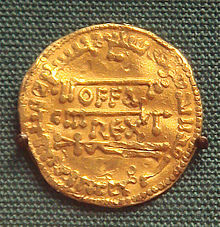

In Sicily, Malta and South Italy from about 913 tarì gold coins of Islamic origin were minted in great number by the Normans, Hohenstaufens and the early Angevins rulers.[124] When the Normans invaded Sicily in the 12th century, they issued tarì coins bearing legends in Arabic and Latin.[125] The tarìs were so widespread that imitations were made in southern Italy (Amalfi and Salerno) which only used illegible "pseudo-Kufic" imitations of Arabic.[126][127]
According to Janet Abu-Lughod:
The preferred specie for international transactions before the thirteenth century, in Europe as well as the Middle East and even India, were the gold coins struck by Byzantium and then Egypt. It was not until after the thirtheenth century that some Italian cities (Florence and Genoa) began to mint their own gold coins, but these were used to supplement rather than supplant the Middle Eastern coins already in circulation.[128]
Literature
The most well known fiction from the Islamic world was The Book of One Thousand and One Nights (Arabian Nights), which was a compilation of many earlier folk tales. The epic took form in the 10th century and reached its final form by the 14th century; the number and type of tales have varied from one manuscript to another.[129] All Arabian fantasy tales were often called "Arabian Nights" when translated into English, regardless of whether they appeared in The Book of One Thousand and One Nights, in any version, and a number of tales are known in Europe as "Arabian Nights" despite existing in no Arabic manuscript.[129]
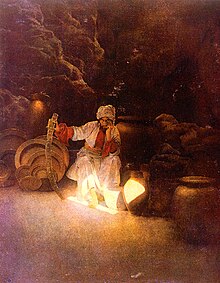
This epic has been influential in the West since it was translated in the 18th century, first by Antoine Galland.[130] Many imitations were written, especially in France.[131] Various characters from this epic have themselves become cultural icons in Western culture, such as Aladdin, Sinbad and Ali Baba. However, no medieval Arabic source has been traced for Aladdin, which was incorporated into The Book of One Thousand and One Nights by its French translator, Antoine Galland, who heard it from an Arab Syrian storyteller from Aleppo. Part of its popularity may have sprung from the increasing historical and geographical knowledge, so that places of which little was known and so marvels were plausible had to be set further "long ago" or farther "far away"; this is a process that continues, and finally culminate in the fantasy world having little connection, if any, to actual times and places. A number of elements from Arabian mythology and Persian mythology are now common in modern fantasy, such as genies, bahamuts, magic carpets, magic lamps, etc.[131] When L. Frank Baum proposed writing a modern fairy tale that banished stereotypical elements, he included the genie as well as the dwarf and the fairy as stereotypes to go.[132]
A famous example of Arabic poetry and Persian poetry on romance (love) is Layla and Majnun, dating back to the Umayyad era in the 7th century. It is a tragic story of undying love much like the later Romeo and Juliet, which was itself said to have been inspired by a Latin version of Layli and Majnun to an extent.[133]
Ibn Tufail (Abubacer) was a pioneer of the philosophical novel. He wrote the first Arabic novel, Hayy ibn Yaqdhan (Philosophus Autodidactus), which told the story of Hayy, an autodidactic feral child, living in seclusion on a desert island, being the earliest example of a desert island story.[134][135] A Latin translation of Ibn Tufail's Hayy ibn Yaqdhan first appeared in 1671, prepared by Edward Pococke the Younger, followed by an English translation by Simon Ockley in 1708, as well as German and Dutch translations. These translations later inspired Daniel Defoe to write Robinson Crusoe, regarded as the first novel in English.[136][137][138][139] Philosophus Autodidactus also inspired Robert Boyle to write his own philosophical novel set on an island, The Aspiring Naturalist.[140] The story also anticipated Rousseau's Emile: or, On Education in some ways[citation needed].
There were several elements of courtly love which developed in Arabic literature. The notions of "love for love's sake" and "exaltation of the beloved lady" have been traced back to Arabic literature of the 9th and 10th centuries. The notion of the "ennobling power" of love was developed in the early 11th century by the Persian psychologist and philosopher, Ibn Sina (known as "Avicenna" in Europe), in his treatise Risala fi'l-Ishq (Treatise on Love). The final element of courtly love, the concept of "love as desire never to be fulfilled", was at times implicit in Arabic poetry. These elements influenced the development of courtly love in European literature, in which all four elements of courtly love were present.[141]
Dante Alighieri's Divine Comedy, considered the greatest epic of Italian literature, derived many features of and episodes about the hereafter directly or indirectly from Arabic works on Islamic eschatology: the Hadith and the Kitab al-Miraj (translated into Latin in 1264 or shortly before[142] as Liber Scale Machometi, "The Book of Muhammad's Ladder") concerning Muhammad's ascension to Heaven, and the spiritual writings of Ibn Arabi. The Moors also had a noticeable influence on the works of George Peele and William Shakespeare. Some of their works featured Moorish characters, such as Peele's The Battle of Alcazar and Shakespeare's The Merchant of Venice, Titus Andronicus and Othello, which featured a Moorish Othello as its title character. These works are said to have been inspired by several Moorish delegations from Morocco to Elizabethan England at the beginning of the 17th century.[143]
Philosophy
From Islamic Spain, the Arabic philosophical literature was translated into Hebrew, Latin, and Ladino, contributing to the development of modern European philosophy. The Jewish philosopher Moses Maimonides, Muslim sociologist-historian Ibn Khaldun, Carthage citizen Constantine the African who translated Greek medical texts, and the Muslim Al-Khwarizmi's collation of mathematical techniques were important figures of the Golden Age.
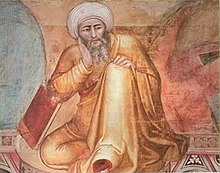
Avicenna founded the Avicennism school of philosophy, which was influential in both Islamic and Christian lands. He was a critic of Aristotelian logic and the founder of Avicennian logic, and he developed the concepts of empiricism and tabula rasa. The main significance of Latin Avicennism lies in the interpretation of Avicennian doctrines such as the nature of the soul and his existence-essence distinction, along with the debates and censure that they raised in scholastic Europe. This was particularly the case in Paris, where Avicennism was later proscribed in 1210, though the influence of his psychology and theory of knowledge upon William of Auvergne and Albertus Magnus have been noted. The effects of Avicennism in Christianity, however, was later submerged by Averroism, a school of philosophy founded by Averroes, one of the most influential Muslim philosophers in the West.[145] His works and commentaries had an impact on the rise of secular thought in Western Europe,[144] and he also developed the concept of "existence precedes essence".[146]
Al-Ghazali also had an important influence on Christian medieval philosophers along with Jewish thinkers like Maimonides.[147] According to Margaret Smith, "There can be no doubt that Ghazali’s works would be among the first to attract the attention of these European scholars" and "The greatest of these Christian writers who was influenced by Al-Ghazali was St. Thomas Aquinas (1225–1274), who made a study of the Islamic writers and admitted his indebtedness to them. He studied at the University of Naples where the influence of Islamic literature and culture was predominant at the time."[148] René Descartes' ideas from his Discourse on the Method were also influenced by al-Ghazali, and Descartes' method of doubt was very much similar to al-Ghazali's work.[149]

Another influential philosopher who had a significant influence on modern philosophy was Ibn Tufail. His philosophical novel, Hayy ibn Yaqdhan, translated into Latin as Philosophus Autodidactus in 1671, developed the themes of empiricism, tabula rasa, nature versus nurture,[151] condition of possibility, materialism,[152] and Molyneux's Problem.[153] European scholars and writers influenced by this novel include John Locke,[154] Gottfried Leibniz,[139] Melchisédech Thévenot, John Wallis, Christiaan Huygens,[155] George Keith, Robert Barclay, the Quakers,[156] and Samuel Hartlib.[140]
Certain aspects of Renaissance humanism also has its roots in the medieval Islamic world, including the "art of dictation, called in Latin, ars dictaminis," and "the humanist attitude toward classical language."[157] There is also evidence that John Locke's formulation of inalienable rights and conditional rulership, which were present in Islamic law centuries earlier, may have also been influenced by Islamic law, through his attendance of lectures given by Edward Pococke, a professor of Islamic studies.[158]
Vocabulary
The adoption of the techniques and materials from the Islamic world is reflected in the origin of many of the Arabic words now in use in the Western world.[159]
- Admiral, from amir al-bahr امير البحر (“Prince of the sea”)
- Alchemy/ Chemistry, from al kemiya' (الكيمياء)
- Algebra, which comes from al-djabr (الجبر)
- Algorithm, from the name of the scientist al-Khwarizmi (الخوارزمي)
- Almanac, from al-manakh (المناخ) (timetables)
- Amber, from Anbar (عنبر)
- Artichoke, from ard-i-choke (أرضِ شوكي)
- Avarie (French for "ship damage"), from awar (عَوَر) ("damage")
- Baldaquin, from a tissue material made in Baghdad
- Camphor, from kafur
- Carat (unit), from qīrāṭ (قيراط) ("mass")
- Coffee, from Kahwa (قهوة)
- Cotton, from koton (قطن)
- Gauze, from qazz (قز) ("raw silk")
- Hazard, from az-zahr (الزهر) (game of dice)
- Lacquer, from lakk
- Lute, from al-ud (العود)
- Magazine, from makhâzin (مخازن)
- Mate (as in "Checkmate"), from mât (مات) ("Death")
- Orange, from nârandj (نارنج)
- Racket, from râhat (راحات) (palm of the hand)
- Sorbet, from sharab (شراب \ شربة)
- Sugar, from soukkar (سكّر)
- Zero, from Greek zephyrus which comes from şifr (صفر) ("zero")
Notes
- ^ a b Lebedel, p.109
- ^ Macdonald, D. B. (April 1931), Reviewed work(s): Historical Facts for the Arabian Musical Influence by Henry George Farmer, vol. 15, pp. 370–372 [371]
{{citation}}: Text "Isis" ignored (help) - ^ ”Without contacts with the Arab culture, Renaissance could probably not have happened in the 15th and 16th century”, Lebedel, p. 109
- ^ Lewis, p.148
- ^ Lebedel, p.109-111
- ^ Lebedel, p. 109
- ^ Fielding H. Garrison, An Introduction to the History of Medicine: with Medical Chronology, Suggestions for Study and Biblographic Data, p. 86
- ^ Lebedel, p.111
- ^ Lebedel, p.112
- ^ a b c d Salah Zaimeche (2003). Aspects of the Islamic Influence on Science and Learning in the Christian West, p. 10. Foundation for Science Technology and Civilisation.
- ^ a b c V. J. Katz, A History of Mathematics: An Introduction, p. 291.
- ^ For a list of Gerard of Cremona's translations see: Edward Grant (1974) A Source Book in Medieval Science, (Cambridge: Harvard Univ. Pr.), pp. 35-8 or Charles Burnett, "The Coherence of the Arabic-Latin Translation Program in Toledo in the Twelfth Century," Science in Context, 14 (2001): at 249-288, at pp. 275-281.
- ^ a b c d e f g Jerome B. Bieber. Medieval Translation Table 2: Arabic Sources, Santa Fe Community College.
- ^ D. Campbell, Arabian Medicine and Its Influence on the Middle Ages, p. 6.
- ^ G. G. Joseph, The Crest of the Peacock, p. 306
- ^ David Pingree (1964), "Gregory Chioniades and Palaeologan Astronomy", Dumbarton Oaks Papers 18, p. 135-160.
- ^ O'Connor, John J.; Robertson, Edmund F., "Abu Abd Allah Muhammad ibn Muadh Al-Jayyani", MacTutor History of Mathematics Archive, University of St Andrews
- ^ D. S. Kasir (1931). The Algebra of Omar Khayyam, p. 6-7. Teacher's College Press, Columbia University, New York.
- ^ Boris A. Rosenfeld and Adolf P. Youschkevitch (1996), "Geometry", p. 469, in (Morelon & Rashed 1996, pp. 447–494)
- ^ "Inventions et decouvertes au Moyen-Age", Samuel Sadaune, p.44
- ^ George Sarton, Introduction to the History of Science.
(cf. Dr. A. Zahoor and Dr. Z. Haq (1997), Quotations From Famous Historians of Science, Cyberistan. - ^ National Library of Medicine digital archives
- ^ David W. Tschanz, MSPH, PhD (August 2003). "Arab Roots of European Medicine", Heart Views 4 (2).
- ^ a b c D. Campbell, Arabian Medicine and Its Influence on the Middle Ages, p. 3.
- ^ Anatomy and Physiology, Islamic Medical Manuscripts, United States National Library of Medicine.
- ^ Sabra, A. I.; Hogendijk, J. P. (2003), The Enterprise of Science in Islam: New Perspectives, MIT Press, pp. 85–118, ISBN 0262194821, OCLC 237875424
- ^ Hatfield, Gary (1996), "Was the Scientific Revolution Really a Revolution in Science?", in Ragep, F. J.; Ragep, Sally P.; Livesey, Steven John (eds.), Tradition, Transmission, Transformation: Proceedings of Two Conferences on Pre-modern Science held at the University of Oklahoma, Brill Publishers, p. 500, ISBN 9004091262, OCLC 19740432
- ^ a b Gorini, Rosanna (2003), "Al-Haytham the Man of Experience: First Steps in the Science of Vision", Journal of the International Society for the History of Islamic Medicine, Institute of Neurosciences, Laboratory of Psychobiology and Psychopharmacology, Rome, Italy:
"According to the majority of the historians al-Haytham was the pioneer of the modern scientific method. With his book he changed the meaning of the term optics and established experiments as the norm of proof in the field. His investigations are based not on abstract theories, but on experimental evidences and his experiments were systematic and repeatable."
- ^ a b R. L. Verma, "Al-Hazen: father of modern optics", Al-Arabi, 8 (1969): 12-13
- ^ a b Thiele, Rüdiger (August 2005), "In Memoriam: Matthias Schramm, 1928–2005", Historia Mathematica, 32 (3): 271–274, doi:10.1016/j.hm.2005.05.002
- ^ Thiele, Rüdiger (2005), "In Memoriam: Matthias Schramm", Arabic Sciences and Philosophy, 15, Cambridge University Press: 329–331, doi:10.1017/S0957423905000214
- ^ Omar Khaleefa (Summer 1999). "Who Is the Founder of Psychophysics and Experimental Psychology?", American Journal of Islamic Social Sciences 16 (2).
- ^ H. Salih, M. Al-Amri, M. El Gomati (2005). "The Miracle of Light", A World of Science 3 (3), UNESCO
- ^ Marshall, Peter (September 1981), "Nicole Oresme on the Nature, Reflection, and Speed of Light", Isis, 72 (3): 357–374 [367–74], doi:10.1086/352787
- ^ a b c Richard Powers (University of Illinois), Best Idea; Eyes Wide Open, New York Times, April 18, 1999.
- ^ Kriss, Timothy C.; Kriss, Vesna Martich (April 1998), "History of the Operating Microscope: From Magnifying Glass to Microneurosurgery", Neurosurgery, 42 (4): 899–907, doi:10.1097/00006123-199804000-00116
- ^ Nicholas J. Wade, Stanley Finger (2001), "The eye as an optical instrument: from camera obscura to Helmholtz's perspective", Perception 30 (10): 1157-77
- ^ a b Falco, Charles M. (12–15 February 2007), Ibn al-Haytham and the Origins of Modern Image Analysis, International Conference on Information Sciences, Signal Processing and its Applications
- ^ Ernest A. Moody (1951), "Galileo and Avempace: The Dynamics of the Leaning Tower Experiment (I)", Journal of the History of Ideas 12 (2): 163-193
- ^ Mariam Rozhanskaya and I. S. Levinova (1996), "Statics", p. 642, in (Morelon & Rashed 1996, pp. 614–642)
- ^ M.-T. d'Alverny, "Translations and Translators," pp. 444-6, 451
- ^ D. Campbell, Arabian Medicine and Its Influence on the Middle Ages, p. 4-5.
- ^ D. Campbell, Arabian Medicine and Its Influence on the Middle Ages, p. 5.
- ^ "Biographisch-Bibliographisches Kirchenlexicon".
- ^ Charles Burnett, ed. Adelard of Bath, Conversations with His Nephew, (Cambridge: Cambridge University Press, 1999), p. xi.
- ^ D. Campbell, Arabian Medicine and Its Influence on the Middle Ages, p. 4.
- ^ M.-T. d'Alverny, "Translations and Translators," pp. 429, 455
- ^ Samar Attar, The Vital Roots of European Enlightenment: Ibn Tufayl's Influence on Modern Western Thought, Lexington Books, ISBN 0739119893.
- ^ Russell McNeil, Ibn al-Baitar, Malaspina University-College
- ^ Roux, p. 47
- ^ ”Les Normans en Sicile”
- ^ Pierre Aubé (2006), Les empires normands d’Orient, p. 164-5, Editions Perrin, ISBN 2262022976
- ^ Mack, p.65-66
- ^ Mack, p.51
- ^ Mack, p.51
- ^ Mack, p.52, p.69
- ^ Freider. p.84 [1]
- ^ "Perhaps they marked the imagery of a universal faith, an artistic intention consistent with the Church's contemporary international program." Mack, p.69
- ^ Christopher Wren (1750). Parentalia: or, Memoirs of the family of the Wrens, viz. of Mathew Bishop, printed for T. Osborn; and R. Dodsley, London.
- ^ Christopher Wren and the Muslim Origin of Gothic Architecture (2003), Foundation for Science Technology and Civilisation.
- ^ a b Peter Barrett (2004), Science and Theology Since Copernicus: The Search for Understanding, p. 18, Continuum International Publishing Group, ISBN 056708969X.
- ^ Ibrahim B. Syed PhD, "Islamic Medicine: 1000 years ahead of its times", Journal of the Islamic Medical Association, 2002 (2), p. 2-9 [7-8].
- ^ Micheau, Francoise, "The Scientific Institutions in the Medieval Near East", pp. 992–3
{{citation}}: Missing or empty|title=(help), in (Rashed & Morelon 1996, pp. 985–1007) - ^ (Gaudiosi 1988)
- ^ (Hudson 2003, p. 32)
- ^ a b Badr, Gamal Moursi (Spring, 1978), "Islamic Law: Its Relation to Other Legal Systems", The American Journal of Comparative Law, 26 (2 - Proceedings of an International Conference on Comparative Law, Salt Lake City, Utah, February 24–25, 1977): 187–198 [196–8], doi:10.2307/839667
{{citation}}: Check date values in:|date=(help) - ^ (Farmer 1988, p. 137)
- ^ (Farmer 1988, p. 140)
- ^ (Farmer 1988, pp. 140–1)
- ^ (Farmer 1988, p. 141)
- ^ (Farmer 1988, p. 142)
- ^ Rabab Saoud (2004). "The Arab Contribution to the Music of the Western World" (PDF). FSTC Limited. Retrieved 2008-06-20.
{{cite web}}: Unknown parameter|month=ignored (help) - ^ (Farmer 1988, p. 143)
- ^ (Farmer 1988, p. 144)
- ^ M. Guettat (1980), La Musique classique du Maghreb (Paris: Sindbad).
- ^ J. B. Trend (1965), Music of Spanish History to 1600 (New York: Krause Reprint Corp.)
- ^ "Troubadour", Grove Dictionary of Music and Musicians, edited by Stanley Sadie, Macmillan Press Ltd., London
- ^ (Farmer 1988, pp. 72–82)
- ^ Miller, Samuel D. (Autumn 1973), "Guido d'Arezzo: Medieval Musician and Educator", Journal of Research in Music Education, 21 (3): 239–45, doi:10.2307/3345093
- ^ a b Andrew M. Watson (1974), "The Arab Agricultural Revolution and Its Diffusion, 700–1100", The Journal of Economic History 34 (1), pp. 8–35.
- ^ David A. King (2002). "A Vetustissimus Arabic Text on the Quadrans Vetus", Journal for the History of Astronomy 33, p. 237-255 [237-238].
- ^ Roberto Moreno, Koenraad Van Cleempoel, David King (2002). "A Recently Discovered Sixteenth-Century Spanish Astrolabe", Annals of Science 59 (4), p. 331-362 [333].
- ^ Regis Morelon, "General Survey of Arabic Astronomy", pp. 9-10, in (Rashed & Morelon 1996, pp. 1–19)
- ^ Donald Routledge Hill (1996), "Engineering", p. 766, in (Rashed & Morelon 1996, pp. 751–95)
- ^ Fielding H. Garrison, History of Medicine
- ^ S. P. Scott (1904), History of the Moorish Empire in Europe, 3 vols, J. B. Lippincott Company, Philadelphia and London.
F. B. Artz (1980), The Mind of the Middle Ages, Third edition revised, University of Chicago Press, pp 148-50.
(cf. References, 1001 Inventions) - ^ Ahmad Y Hassan, Transfer Of Islamic Technology To The West, Part II: Transmission Of Islamic Engineering, History of Science and Technology in Islam
- ^ Lynn Townsend White, Jr., quoted in The Automata of Al-Jazari, The Topkapi Palace Museum, Istanbul
- ^ Segment gear, TheFreeDictionary.com
- ^ Ahmad Y Hassan, Transfer Of Islamic Technology To The West, Part III: Technology Transfer in the Chemical Industries, History of Science and Technology in Islam.
- ^ Middle Ages
- ^ British Museum notice
- ^ J. H. Galloway (1977), "The Mediterranean Sugar Industry", Geographical Review 67 (2), pp. 177–94.
- ^ Ahmad Y Hassan, Transfer Of Islamic Technology To The West, Part 1: Avenues Of Technology Transfer
- ^ Adam Lucas (2006), Wind, Water, Work: Ancient and Medieval Milling Technology, p. 10 & 65, BRILL, ISBN 9004146490.
- ^ Ahmad Y Hassan. The Crank-Connecting Rod System in a Continuously Rotating Machine.
- ^ Ahmad Y Hassan. The Origin of the Suction Pump.
- ^ Zohor Idrisi (2005), The Muslim Agricultural Revolution and its influence on Europe, FSTC.
- ^ Adam Robert Lucas (2005), "Industrial Milling in the Ancient and Medieval Worlds: A Survey of the Evidence for an Industrial Revolution in Medieval Europe", Technology and Culture 46 (1), p. 1-30.
- ^ "Partnership and Profit in Medieval Islam by Abraham L. Udovitch".
- ^ Banaji, Jairus (2007). "Islam, the Mediterranean and the rise of capitalism". Journal Historical Materialism. 15. Brill Publishers: 47–74. doi:10.1163/156920607X171591.
- ^ Shatzmiller, Maya (1994). Labour in the Medieval Islamic World. Brill Publishers. pp. 402–403. ISBN 9004098968.
- ^ Labib, Subhi Y. (1969). "Capitalism in Medieval Islam". The Journal of Economic History. 29: 79–96.
- ^ a b c Alatas, Syed Farid (2006), "From Jami`ah to University: Multiculturalism and Christian–Muslim Dialogue", Current Sociology, 54 (1): 112–32, doi:10.1177/0011392106058837
- ^ a b c d e f g (Makdisi 1999)
- ^ a b c d e Makdisi, George (April–June 1989), "Scholasticism and Humanism in Classical Islam and the Christian West", Journal of the American Oriental Society, 109 (2): 175–182 [175–77], doi:10.2307/604423
{{citation}}: CS1 maint: date format (link) - ^ The Guinness Book Of Records, 1998, p. 242, ISBN 0-5535-7895-2
- ^ William J. Courtenay, Jürgen Miethke, David B. Priest (2000), Universities and Schooling in Medieval Society, Brill Publishers, ISBN 9004113517, p. 96
- ^ Toby E. Huff (2003), The Rise of Early Modern Science: Islam, China and the West, Cambridge University Press, pp. 77-8
- ^ Goddard, Hugh (2000), A History of Christian-Muslim Relations, Edinburgh University Press, p. 100, ISBN 074861009X, OCLC 237514956
- ^ a b Mukul Devichand (24 September 2008). "Is English law related to Muslim law?". BBC News. Retrieved 2008-10-05.
- ^ Hussain, Jamila (2001), "Book Review: The Justice of Islam by Lawrence Rosen", Melbourne University Law Review, 30
- ^ El-Gamal, Mahmoud A. (2006), Islamic Finance: Law, Economics, and Practice, Cambridge University Press, p. 16, ISBN 0521864143, OCLC 173610010
- ^ Gaudiosi, Monica M. (April 1988), "The Influence of the Islamic Law of Waqf on the Development of the Trust in England: The Case of Merton College", University of Pennsylvania Law Review, 136 (4): 1231–1261
{{citation}}: CS1 maint: date and year (link) - ^ Hudson, A. (2003), Equity and Trusts (3rd ed.), London: Cavendish Publishing, p. 32, ISBN 1-85941-729-9
- ^ Badr, Gamal Moursi (Spring, 1978), "Islamic Law: Its Relation to Other Legal Systems", The American Journal of Comparative Law, 26 (2 [Proceedings of an International Conference on Comparative Law, Salt Lake City, Utah, February 24–25, 1977]): 187–198 [196–8], doi:10.2307/839667
{{citation}}: Check date values in:|date=(help) - ^ (Badr 1978, pp. 197) harv error: multiple targets (3×): CITEREFBadr1978 (help)
- ^ a b c d Boisard, Marcel A. (July 1980), "On the Probable Influence of Islam on Western Public and International Law", International Journal of Middle East Studies, 11 (4): 429–50
- ^ Weeramantry, Judge Christopher G. (1997), Justice Without Frontiers: Furthering Human Rights, Brill Publishers, ISBN 9041102418, OCLC 219748178
- ^ a b c Judge Weeramantry, Christopher G. (1997), Justice Without Frontiers, Brill Publishers, pp. 129–32, ISBN 9041102418, OCLC 219748178
- ^ a b Judge Weeramantry, Christopher G. (1997), Justice Without Frontiers, Brill Publishers, pp. 136–7, ISBN 9041102418, OCLC 219748178
- ^ British Museum
- ^ British Museum notice
- ^ Blanchard, Ian Mining, Metallurgy and Minting in the Middle Ages Franz Steiner Verlag, 2001 ISBN 9783515079587 [2], p.196
- ^ British Museum, Islamic Art room
- ^ Cardini, Franco Europe and Islam Blackwell Publishing, 2001 ISBN 9780631226376 [3], p.26
- ^ Grierson, Philip Medieval European Coinage Cambridge University Press, 1998 ISBN 9780521582315 [4], p.3
- ^ Janet Abu-Lughod Before European Hegemony, The World System A.D. 1250-1350, Oxford University Press, ISBN 0195067746 p.15
- ^ a b John Grant and John Clute, The Encyclopedia of Fantasy, "Arabian fantasy", p 51 ISBN 0-312-19869-8
- ^ L. Sprague de Camp, Literary Swordsmen and Sorcerers: The Makers of Heroic Fantasy, p 10 ISBN 0-87054-076-9
- ^ a b John Grant and John Clute, The Encyclopedia of Fantasy, "Arabian fantasy", p 52 ISBN 0-312-19869-8
- ^ James Thurber, "The Wizard of Chitenango", p 64 Fantasists on Fantasy edited by Robert H. Boyer and Kenneth J. Zahorski, ISBN 0-380-86553-X
- ^ "Nizami: Layla and Majnun - English Version by Paul Smith".
- ^ Dr. Abu Shadi Al-Roubi (1982), "Ibn Al-Nafis as a philosopher", Symposium on Ibn al-Nafis, Second International Conference on Islamic Medicine: Islamic Medical Organization, Kuwait (cf. Ibn al-Nafis As a Philosopher, Encyclopedia of Islamic World).
- ^ Nahyan A. G. Fancy (2006), "Pulmonary Transit and Bodily Resurrection: The Interaction of Medicine, Philosophy and Religion in the Works of Ibn al-Nafīs (d. 1288)", p. 95-101, Electronic Theses and Dissertations, University of Notre Dame.[5]
- ^ Nawal Muhammad Hassan (1980), Hayy bin Yaqzan and Robinson Crusoe: A study of an early Arabic impact on English literature, Al-Rashid House for Publication.
- ^ Cyril Glasse (2001), New Encyclopedia of Islam, p. 202, Rowman Altamira, ISBN 0759101906.
- ^ Amber Haque (2004), "Psychology from Islamic Perspective: Contributions of Early Muslim Scholars and Challenges to Contemporary Muslim Psychologists", Journal of Religion and Health 43 (4): 357-377 [369].
- ^ a b Martin Wainwright, Desert island scripts, The Guardian, 22 March 2003.
- ^ a b G. J. Toomer (1996), Eastern Wisedome and Learning: The Study of Arabic in Seventeenth-Century England, p. 222, Oxford University Press, ISBN 0198202911.
- ^ G. E. von Grunebaum (1952), "Avicenna's Risâla fî 'l-'išq and Courtly Love", Journal of Near Eastern Studies 11 (4): 233-8 [233-4].
- ^ I. Heullant-Donat and M.-A. Polo de Beaulieu, "Histoire d'une traduction," in Le Livre de l'échelle de Mahomet, Latin edition and French translation by Gisèle Besson and Michèle Brossard-Dandré, Collection Lettres Gothiques, Le Livre de Poche, 1991, p. 22 with note 37.
- ^ Professor Nabil Matar (April 2004), Shakespeare and the Elizabethan Stage Moor, Sam Wanamaker Fellowship Lecture, Shakespeare’s Globe Theatre (cf. Mayor of London (2006), Muslims in London, pp. 14-15, Greater London Authority)
- ^ a b Majid Fakhry (2001). Averroes: His Life, Works and Influence. Oneworld Publications. ISBN 1851682694.
- ^ Corbin (1993), p.174
- ^ Irwin, Jones (Autumn 2002), "Averroes' Reason: A Medieval Tale of Christianity and Islam", The Philosopher, LXXXX (2)
- ^ Ormsby, Eric. "Averroes (Ibn Rushd): His Life, Works and Influence". H-Net Review. See also: "The Influence of Islamic Thought on Maimonides". Stanford Encyclopedia of Philosophy. Retrieved 2008-08-28.
- ^ Margaret Smith, Al-Ghazali: The Mystic (London 1944)
- ^ Najm, Sami M. (July–October 1966), "The Place and Function of Doubt in the Philosophies of Descartes and Al-Ghazali", Philosophy East and West, 16 (3–4): 133–41, doi:10.2307/1397536
{{citation}}: CS1 maint: date format (link) - ^ "Inventions et decouvertes au Moyen-Age", Samuel Sadaune, p.112
- ^ G. A. Russell (1994), The 'Arabick' Interest of the Natural Philosophers in Seventeenth-Century England, pp. 224-262, Brill Publishers, ISBN 9004094598.
- ^ Dominique Urvoy, "The Rationality of Everyday Life: The Andalusian Tradition? (Aropos of Hayy's First Experiences)", in Lawrence I. Conrad (1996), The World of Ibn Tufayl: Interdisciplinary Perspectives on Ḥayy Ibn Yaqẓān, pp. 38-46, Brill Publishers, ISBN 9004093001.
- ^ Muhammad ibn Abd al-Malik Ibn Tufayl and Léon Gauthier (1981), Risalat Hayy ibn Yaqzan, p. 5, Editions de la Méditerranée.[6]
- ^ G. A. Russell (1994), The 'Arabick' Interest of the Natural Philosophers in Seventeenth-Century England, pp. 224-239, Brill Publishers, ISBN 9004094598.
- ^ G. A. Russell (1994), The 'Arabick' Interest of the Natural Philosophers in Seventeenth-Century England, p. 227, Brill Publishers, ISBN 9004094598.
- ^ G. A. Russell (1994), The 'Arabick' Interest of the Natural Philosophers in Seventeenth-Century England, p. 247, Brill Publishers, ISBN 9004094598.
- ^ Makdisi, George (April–June 1989), "Scholasticism and Humanism in Classical Islam and the Christian West", Journal of the American Oriental Society, 109 (2): 175–182, doi:10.2307/604423
{{citation}}: CS1 maint: date format (link) - ^ Judge Weeramantry, Christopher G. (1997), Justice Without Frontiers, Brill Publishers, pp. 8, 135, 139–40, ISBN 9041102418, OCLC 219748178
- ^ Lebedel, p.113
References
- Badr, Gamal Moursi (Spring 1978), "Islamic Law: Its Relation to Other Legal Systems", The American Journal of Comparative Law, 26 (2 [Proceedings of an International Conference on Comparative Law, Salt Lake City, Utah, February 24–25, 1977]): 187–198, doi:10.2307/839667
{{citation}}: CS1 maint: date and year (link) - Farmer, Henry George (1988), Historical facts for the Arabian Musical Influence, Ayer Publishing, ISBN 040508496X, OCLC 220811631
- Lebedel, Claude (2006), Les Croisades, origines et conséquences, Editions Ouest-France, ISBN 2737341361, OCLC 181885553
- Lewis, Bernard (1993), Les Arabes dans l'histoire, Flammarion, ISBN 2080813625, OCLC 36229500
- Makdisi, John A. (June 1999), "The Islamic Origins of the Common Law", North Carolina Law Review, 77 (5): 1635–1739
- Roux, Jean-Paul (1985), Les explorateurs au Moyen-Age, Hachette, ISBN 2012793398
- Braden K. Frieder Chivalry & the perfect prince: tournaments, art, and armor at the Spanish Habsburg court Truman State University, 2008 ISBN 193111269X, ISBN 9781931112697
- Cardini, Franco. Europe and Islam. Blackwell Publishing, 2001. ISBN 9780631226376
- Grierson, Philip Medieval European Coinage Cambridge University Press, 2007 ISBN 052103177X, ISBN 9780521031776
- Mack, Rosamond E. Bazaar to Piazza: Islamic Trade and Italian Art, 1300-1600, University of California Press, 2001 ISBN 0520221311
- Matthew, Donald, The Norman kingdom of Sicily Cambridge University Press, 1992 ISBN 9780521269117}}


